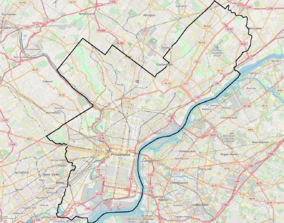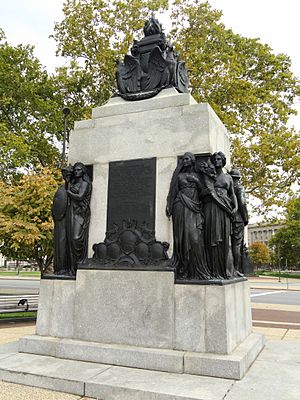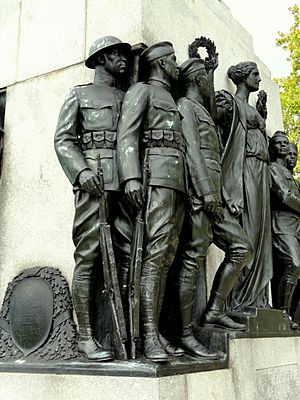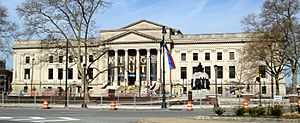All Wars Memorial to Colored Soldiers and Sailors facts for kids
Quick facts for kids All Wars Memorial to Colored Soldiers and Sailors |
|
|---|---|
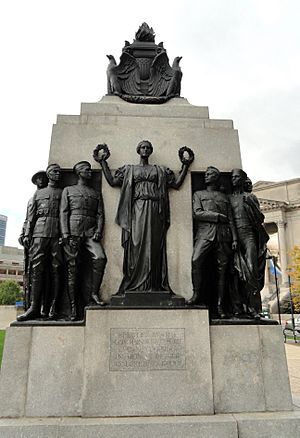 |
|
| Location | Logan Square, SE corner 20th Street & Benjamin Franklin Parkway, Philadelphia, Pennsylvania |
| Established | Dedicated July 7, 1934 Rededicated November 11, 1994 |
| Governing body | City of Philadelphia |
The All Wars Memorial to Colored Soldiers and Sailors is a special monument in Philadelphia, Pennsylvania. It honors African American soldiers and sailors from Pennsylvania who served in many American wars. These wars include the American Revolutionary War up to World War I. The state of Pennsylvania asked for this monument to be built in 1927. Sculptor J. Otto Schweizer created it, and it was first dedicated on July 7, 1934. In 1994, the memorial was moved from a quiet spot to a more important place in Logan Square, along the Benjamin Franklin Parkway.
Contents
What the Memorial Looks Like
The monument is about 21.5 feet (6.55 meters) tall. Its base is about 17 feet (5.18 meters) wide and 13.5 feet (4.11 meters) deep. It is made of strong granite stone, and the statues are made of bronze metal.
Figures and Symbols on the Memorial
On the front, you'll see a female figure representing Justice. She holds a laurel wreath in each hand. These wreaths stand for Honor and Reward. On her right side are two soldiers and one sailor. On her left are three more soldiers. All of them wear World War I uniforms.
The back of the monument has four female figures. They represent War, Liberty, Peace, and Plenty. There is also a special plaque with a dedication message. A carving of the Seal of Pennsylvania is also on the back. At the very top, four American eagles guard The Torch of Life.
All the bronze figures are about 6 feet (1.83 meters) tall. The Justice figure stands a bit higher than the others. Below her, an inscription reads: "Erected by the Commonwealth of Pennsylvania in Honor of Her Colored Soldiers."
Dedication and War Lists
The bronze plaque on the back says: "To Commemorate the Heroism and Sacrifice of All Colored Soldiers Who Served in the Various Wars Engaged in By the United States of America That a Lasting Record Shall Be Made of Their Unselfish Devotion to Duty As an Inspiration to Future Generations ThIs Monument is Dedicated May 30, 1934". It also lists the people who helped make it happen.
On the right side, a bronze shield lists wars like the "American Revolution", "Civil War", and "Indian Wars". On the left side, another shield lists "Spanish American War", "Philippine Insurrection", and "World War."
Where the Memorial Stands Today
The monument is in the southwest part of Logan Square. This is between 20th Street and a traffic circle. It faces the Benjamin Franklin Parkway. The Franklin Institute is to its west. Moore College of Art is to its south. The main Free Library of Philadelphia is to its north. The Cathedral Basilica of Saints Peter and Paul is to its east.
Other nearby monuments include the Aero Memorial. This one honors aviators who died in World War I. The Swann Memorial Fountain is in the center of the traffic circle. There is also the Shakespeare Memorial.
History of the Memorial
In 1925, Samuel Beecher Hart, an African-American state leader from Philadelphia, wanted to create a monument. He introduced a bill to honor 150 years of service by African Americans from Pennsylvania in the U.S. military. He hoped it would be ready for the Sesquicentennial Exposition. This was a big fair in Philadelphia in 1926. It celebrated 150 years since the Declaration of Independence.
His first bill did not pass in 1925. But he tried again in 1927, and this time it passed! The bill first set aside $100,000 for the monument. However, this amount was later lowered to $60,000. Then, Governor John Stuchell Fisher reduced it further to $50,000.
In 1921, Philadelphia had already put up two monuments for the American Civil War. One was for soldiers, and one for sailors. These were placed on the new Benjamin Franklin Parkway. The All Wars Memorial was also planned for this important Parkway.
Choosing a Location: The "Site Wars"
The bill created a 7-person group called the Colored Soldiers Statue Commission. This group was in charge of the monument. Five of the governor's chosen members, including Samuel Beecher Hart, were African Americans.
Twelve sculptors competed to design the monument. J. Otto Schweizer was chosen as the winner. He signed a contract in March 1929. But it took five years to agree on where to put the monument!
Philadelphia's Art Jury did not want the monument on the Parkway. They thought the Parkway had too many war memorials already. They suggested Fitler Square instead. This was a smaller park in a different neighborhood.
John Marquess, an important African-American leader, spoke out against this. He said Fitler Square was "a wilderness" and not a good place for such an important monument. He felt it was an insult to their patriotism. The state commission refused to agree to the Fitler Square site. This caused a big problem.
Finding a Compromise
In March 1934, the monument's dedication was planned for May 30. The Fairmount Park Commission suggested a temporary spot on the Parkway. But the Art Jury said no.
City Councilman Henry Trainer then proposed that the monument be placed permanently on the Parkway. The City Council approved this, and the mayor signed it. This made them popular with African-American voters. However, the Art Jury was the only group with the legal power to decide where monuments went.
Other groups whose monuments had been rejected for the Parkway also complained. They felt if their memorials couldn't be on the Parkway, then no one else's should either.
Under pressure, the Art Jury finally agreed to a compromise in April. The monument would be placed in West Fairmount Park. This was on Lansdowne Avenue, behind Memorial Hall. The dedication was delayed from May 30 to July 7, 1934. State Representative Hart gave a speech. His 11-year-old granddaughter, Doris, was one of six children who helped unveil the monument.
Moving the Memorial to a Better Spot
For many years, people wanted to move the monument to a more visible place. But there was never enough money.
In 1994, the City's Art Commission (which used to be the Art Jury) suggested moving the monument to the Benjamin Franklin Parkway. Philadelphia Mayor Edward Rendell agreed. The City Council provided $200,000 for the move.
The plan to move it was announced on May 9, 1994. Samuel Beecher Hart's granddaughter and two of J. Otto Schweizer's granddaughters were there. The monument was carefully cleaned and fixed. It was re-dedicated on Veterans Day, November 11, 1994. Doris Jones Holliday, Hart's granddaughter, who had unveiled it 60 years earlier, did the honors again.
Why the Memorial is Important
Art historian Ilene D. Lieberman points out that it was very rare to have a public monument in the early 1900s that honored African Americans. It was also rare to see black figures shown equally with white figures.
She compares it to Boston's Robert Gould Shaw Memorial (1884). In that monument, sculptor Augustus Saint-Gaudens honored the all-black 54th Massachusetts Infantry Regiment. He made each soldier's face unique. Those black soldiers are shown supporting the white officer, Shaw, on his horse.
In the Philadelphia monument, the black soldiers and sailors are not just supporting figures. They stand equally with the white goddesses.
Lieberman reminds us that the All Wars Memorial was created when the U.S. military was still strictly separated by race. Black soldiers' abilities and bravery were often questioned. Despite this, African Americans continued to serve in the armed forces. They showed their loyalty to a country that still treated them unfairly.
She also notes that the monument's current location has some issues. The front, with Justice and the six black soldiers and sailors, faces the busy Parkway. But the back, with the four white goddesses, faces the Franklin Institute and a sidewalk. More people might see the back. Also, like the large statue of William Penn on top of Philadelphia City Hall, the monument faces northeast. This means the figures of Justice and the black servicemen are in shadow for much of the day.
See also
 In Spanish: Monumento conmemorativo a los soldados y marineros de color de todas las guerras para niños
In Spanish: Monumento conmemorativo a los soldados y marineros de color de todas las guerras para niños


